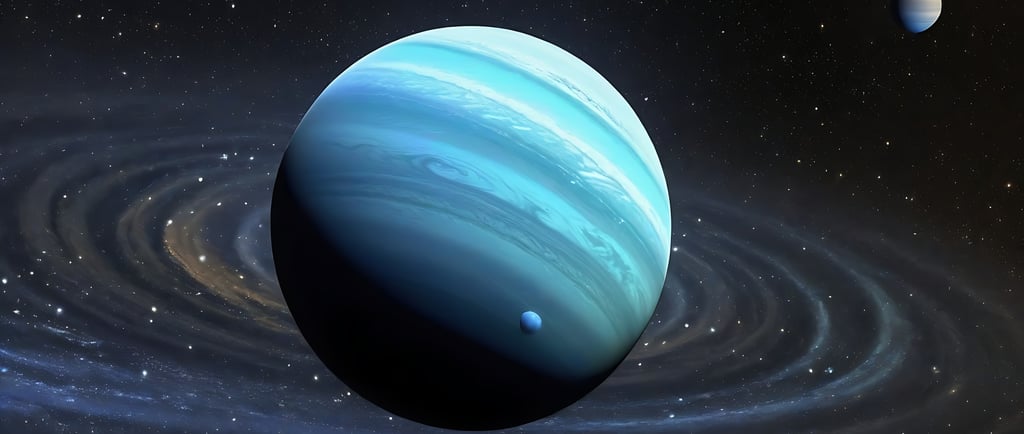Neptune planet
Neptune is the eighth and farthest known planet from the Sun in our solar system. It is a gas giant, similar to Uranus, and is composed primarily of hydrogen, helium, and trace amounts of methane. Neptune was discovered in 1846 through mathematical predictions rather than direct observation.


Introduction
Neptune, the eighth and farthest known planet from the Sun, has captivated astronomers and space enthusiasts alike since its discovery in 1846. This gas giant, named after the Roman god of the sea, is a fascinating celestial body that continues to intrigue scientists with its unique features and enigmatic atmosphere. In this article, we will delve into the discovery of Neptune, explore its atmospheric composition, uncover intriguing facts about the planet, and even touch upon its connection with astrology.
Discovery of Neptune
The discovery of Neptune is a remarkable tale of scientific ingenuity and mathematical predictions. Prior to its identification, astronomers observed irregularities in the orbit of Uranus, suggesting the presence of an unknown planet. Urbain Le Verrier, a French mathematician, and John Couch Adams, a British mathematician, independently calculated the position of this mysterious planet based on these irregularities.
In 1846, Johann Galle, a German astronomer, received a letter from Le Verrier detailing the predicted location of the unknown planet. Galle used these calculations to identify Neptune, making it the first planet to be discovered through mathematical predictions rather than direct observation. This monumental discovery solidified the power of mathematical modeling in astronomy.
The Atmosphere of Neptune
Neptune's atmosphere is a complex and dynamic system, characterized by its vivid blue color and turbulent weather patterns. Composed primarily of hydrogen and helium, with traces of methane, the atmosphere of Neptune differs significantly from that of its gas giant counterparts, Jupiter and Saturn.
The presence of methane in Neptune's atmosphere gives rise to its distinctive blue hue. Methane absorbs red light, reflecting blue light back into space and giving the planet its striking appearance. Additionally, the atmosphere is known for its high-speed winds, reaching speeds of up to 1,500 miles per hour (2,400 kilometers per hour) - the fastest in the solar system.
Facts about Neptune
Neptune, with its intriguing characteristics, continues to captivate astronomers and researchers. Here are some fascinating facts about this distant planet:
- Neptune is the fourth-largest planet in terms of diameter and the third-most massive planet in the solar system.
- It takes Neptune approximately 165 Earth years to complete one orbit around the Sun.
- The planet has a total of 14 known moons, with Triton being the largest and most interesting of them all.
- Neptune experiences extreme seasons due to its tilted axis, similar to Earth.
- Despite its distance from the Sun, Neptune emits more energy than it receives, primarily due to its internal heat.
The Great Dark Spot
One of the most captivating features of Neptune is the Great Dark Spot, a massive storm system similar to Jupiter's Great Red Spot. The Great Dark Spot was first observed by the Voyager 2 spacecraft during its flyby in 1989.
This storm system, spanning over 7,500 miles (12,000 kilometers), is characterized by its dark, swirling clouds and intense atmospheric activity. However, unlike Jupiter's Great Red Spot, which has been observed for centuries, the Great Dark Spot disappeared by the time the Hubble Space Telescope observed Neptune in the 1990s, leaving scientists puzzled about its transient nature.
Triton's Retrograde Orbit
Triton, Neptune's largest moon, is a celestial oddity in its own right. What sets Triton apart from other moons in the solar system is its retrograde orbit, meaning it orbits Neptune in the opposite direction of the planet's rotation.
This peculiar orbit suggests that Triton was not originally a moon of Neptune but rather a captured object. Scientists believe that Triton was once an independent dwarf planet that was captured by Neptune's gravitational pull, causing it to adopt its current retrograde orbit. The study of Triton provides valuable insights into the dynamics of moon formation and capture in the early solar system.
Neptune and Astrology
While astrology primarily focuses on the influence of celestial bodies on human lives, Neptune holds a special place in astrological interpretations. In astrology, Neptune is associated with spirituality, dreams, illusions, and creativity.
Neptune's ethereal nature is believed to influence individuals who possess a strong connection to the arts, imagination, and the subconscious mind. It is often associated with heightened intuition, compassion, and a deep sense of empathy.
However, it is important to note that astrology is a subject of personal belief and interpretation, and its connection with Neptune should be approached with an open mind.
Conclusion
Neptune, with its fascinating history, unique atmosphere, and captivating features, continues to intrigue scientists and space enthusiasts alike. From its discovery through mathematical predictions to its enigmatic atmosphere and celestial wonders like the Great Dark Spot and Triton's retrograde orbit, Neptune offers a wealth of mysteries waiting to be unraveled. Whether through scientific exploration or astrological interpretation, Neptune's allure is sure to endure for generations to come.
